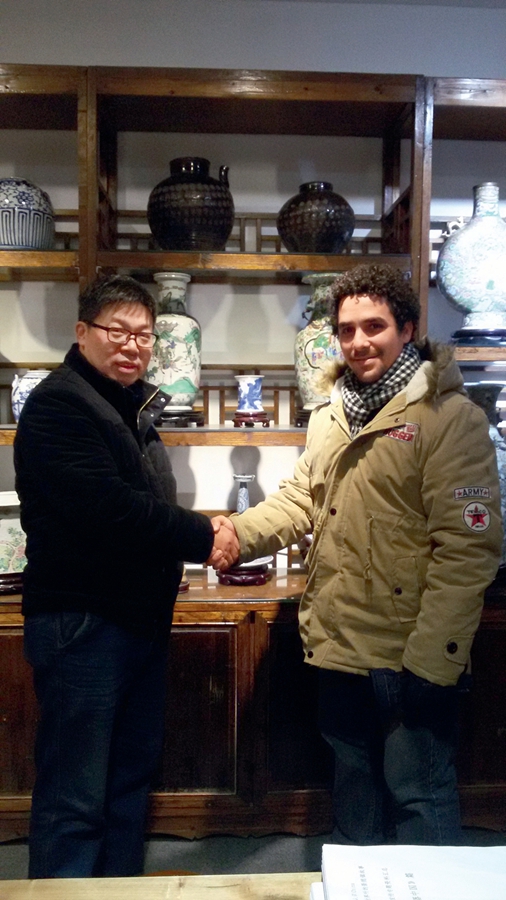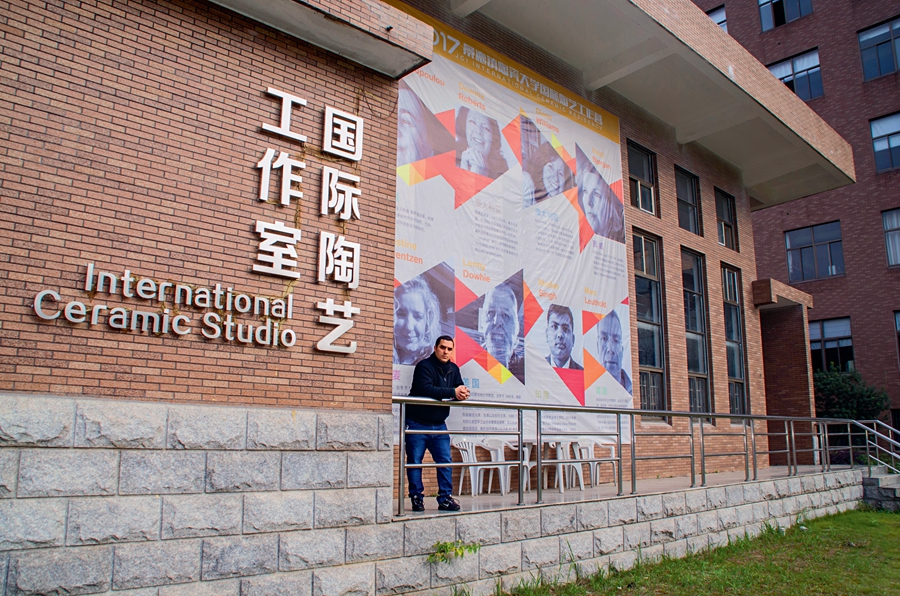By staff reporter ABEL ROSALES GINARTE
CREATING an impermeable, light and hard article, resistant to lime and acids, capable of being used to hold food and preserving medicines was an unquestionable advancement in the history of humanity. When the use of porcelain was first recorded in the third century of our era, the secret of its elaboration was also born. It wasn’t until 1,700 years later that Europe was able to successfully produce this remarkable Chinese invention.
Scholars assure that the best porcelain was produced during the Song Dynasty (960-1279). It was exactly in the Jingde period (1004-1007) that Emperor Zhenzong decreed to establish porcelain production north of Jiangxi Province in Southeast China. Each piece had the emblem “made in the Jingde period,” especially for the imperial family. People ended up calling this place Jingdezhen (Town of Jingde), which nowadays is known as the capital of Chinese porcelain.
Yosvanis with his tutor Dr. Cao Jianwen, professor at the University of Ceramics in Jingdezhen.
In later imperial dynasties, Chinese porcelain traveled the world along the Silk Road. The Encyclopedia of Chinese Culture, by the Peruvian sinologist Guillermo Dañino, highlighted that “the first porcelain object that arrived in Europe, carried by the Portuguese, was in 1570.” The attractive and delicate objects also reached the Caribbean, to the island of Cuba.
Yosvanis Fornaris Garcell, curator and conserver of the Asian art collections of the National Museum of Decorative Arts of Havana, has been studying for a master’s degree in the history of Chinese porcelain at the University of Ceramics in Jingdezhen since 2014.
Impact of Chinese Culture
When he was tasked to dedicate himself to the study of the Asian art collection of the museum, Fornaris discovered novel cultural objects and codes. “It was shocking to see, for the first time, mythological animals, human figures, techniques, and artistic objects completely distant in terms of culture, and from there my attitude toward Asian culture, mainly Chinese, was extremely receptive and curious.”
The National Museum of Decorative Arts (MNAD) is located in one of the palaces of the Havana district of El Vedado, with a small library that has valuable volumes dedicated to the study of Chinese porcelain. “[These come] mainly from private and public collections in England, a country widely known for its inexhaustible thirst for collecting Chinese art,” explains Fornaris, who has a degree in education, specializing in plastics arts education, with extensive experience as a teacher.
Furniture, pieces of jade, ivory, textiles, plastics arts “and above all, porcelain, a lot of Chinese porcelain,” distinguish the collection of Asian art of the MNAD of Havana, but finding information from a Chinese perspective of the porcelain pieces was impossible. “The Ministries of Culture and Higher Education of Cuba together with the Embassy of China in Havana began the process of applying for a four-year scholarship for me, which happily concluded with my arrival in China in September 2014.”
After finishing his studies in China, the arduous task of authenticating the pieces that the museum owns awaited him. “I was very clear that the collection are mostly pieces that had been produced in Jingdezhen in different dynasties and kingdoms, that’s how my passion started and, with that, my dream of becoming an expert in Chinese porcelain.”
The Epicenter of Porcelain
But his first encounter with the capital of Chinese porcelain was not as expected. “I was born and have lived all my life in the historic center of Old Havana, a world heritage site, with varied architectural styles, and Jingdezhen lacks that,” said the Cuban specialist.
The city where Fornaris currently lives has been a fundamental area in the production of porcelain, “the most refined pottery ever produced, the best in the history of humankind and, therefore, a city of workers, artisans, not wealthy families or members of the court that could build large urban areas.” This ensures that people in the area closest to a historic center or an urban area can appreciate the ancient architecture both in the county of Fulian and in the town of Yaoli.
At the new campus of the University of Ceramics in Jingdezhen. Photos courtesy of Yosvanis Fornaris Garcell
The University of Ceramics of Jingdezhen was founded in 1910 and is the only one of its kind in the country that helps the cultivation of talent, innovation, technological development, and the expansion of the culture of Chinese ceramics. Studying there is a privilege that Fornaris recognizes: “There is no other way to express it.” A young Cuban, eager to become a researcher and scholar of Chinese porcelain, suddenly finds himself at the global epicenter of the production of scientific knowledge about the subject.
Thanks to studies and training he received, Fornaris mentioned with absolute certainty that the MNAD of Havana has a collection of Chinese porcelain close to 2,000 pieces from the Song, Tang, Ming, and Qing dynasties, fired in ovens from Jingdezhen, Longquan, Fujian, Dehua, and Guangzhou.
“One of the highlights of the collection itself is the set of works from the periods of emperors Shunzhi, Kangxi, Yongzheng, and Qianlong of the Qing Dynasty, with pieces of great historical research and artistic value.” Someday, he will write the catalog of the Cuban collection of Chinese porcelain.
Cuban musical rhythms help Fornaris deal with the distance that separates him from his land. Although he does not drink coffee or smoke, he loves to cook and eat Cuban food. “I cook a lot, especially black beans that I bring from Cuba and I make congrí. When I want to invite my Chinese friends to eat, I always prepare the Cuban dish that never disappoints – the Cuban ajiaco.” He misses the yucca and the avocado, but in Jingdezhen, he finds red beans and chickpeas. “I am very nostalgic, I was born in a very close and very affectionate family environment, so I constantly need to have a close family.” He is currently accompanied by his wife, with whom he can share the winter and important dates such as Christmas or February 14.
“In my life, China was the great unknown, the distant and inaccessible source that I wanted to drink in. Every investigation or new text that I found made it more chimerical and unattainable,” Fornaris said.
Within several months, Fornaris will be the only Cuban specialized in Chinese porcelain, which will undoubtedly strengthen the cultural ties between the two countries. “I will always be in debt to both governments for having granted me such an opportunity, but the greatest impact will undoubtedly be seen in the dissemination and preservation of the artistic and cultural heritage existing in Cuba and, in this case, that of Chinese origin.” Other museums and cultural institutions in Cuba also have works of Chinese porcelain that await the eyes of an expert trained at the University of Ceramics in Jingdezhen.

